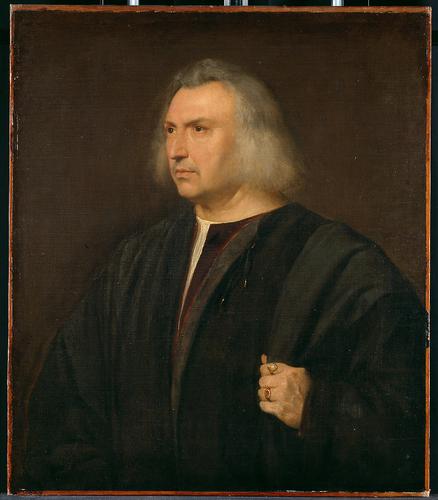Beskrivelse
The painting "Gian Giacomo Bartolotti da Parma", painted by Tiziano Vecellio in 1518, is an emblematic work that illustrates the Venetian master's virtuosity in portraiture, a genre that he mastered and that allowed him to explore both the psychology and the beauty of his models. This visual panegyric represents a moment of encounter between nobility and technical skill, where each brushstroke seems to tell a story.
The composition of the work is notable for its balance and for the way in which the central subject, Gian Giacomo Bartolotti, is presented in a space that seems charged with meaning. He appears in a subtle gesture that reflects both his status and his character. The tilt of his head and the expression on his face suggest deep introspection, while inviting the viewer to a direct connection with his being. Bartolotti is dressed in a rich dark garment that contrasts with the play of light and shadow, a treatment that is characteristic of Titian's style.
The colours in this work are a testament to Titian's mastery of colour and light. The palette is composed of dark, earthy tones that are brightened by touches of warm brown that bring the sitter's face to life. This use of colour not only gives volume and deepens the three-dimensionality of the character, but also reveals Titian's ability to capture the essence of human skin, a distinctive feature of his work.
The canvas is not just a portrait; it encapsulates the essence of the period. The dark background glows in a deep black, accentuating the subject and his clothing, a strategy designed to draw the viewer's attention to the human figure. This use of the dark background is not accidental, but relates to the tradition of Venetian portraiture, in which the figure stands out dramatically against an empty space that seems to absorb the light, creating an aura of dignity and nobility.
The portrait of Gian Giacomo Bartolotti da Parma is framed within a context of portraits that Titian made throughout his career, where he linked his technique with the demands of an aristocracy that sought to immortalize their images on canvas. Works such as the portraits of the Scipione family or members of the court played a significant role in the construction of the memory and legacy of public figures in the Republic of Venice.
The piece also represents an early period in Titian’s work, before he adopted a greater fluidity in his technique that would lead to an early impressionism in his later works. “Gian Giacomo Bartolotti da Parma” should be appreciated not only as a portrait, but as an example of the intersection between technique, color, and atmosphere of the Venetian Renaissance.
By the second decade of the 16th century, Titian had already established himself as one of the greatest exponents of European art, not only for his ability to capture visual reality, but also for generating an emotional connection with the viewer. Bartolotti's figure, with its aristocratic bearing, serves not only as a means to explore the representation of the individual, but as a testament to the place that the human figure occupies in Titian's art and, by extension, in the Venetian culture of the time.
KUADROS ©, a famous painting on your wall.
Hand-made oil painting reproductions, with the quality of professional artists and the distinctive seal of KUADROS ©.
Painting reproduction service with satisfaction guarantee. If you are not completely satisfied with the replica of your painting, we will refund 100% of your money.

